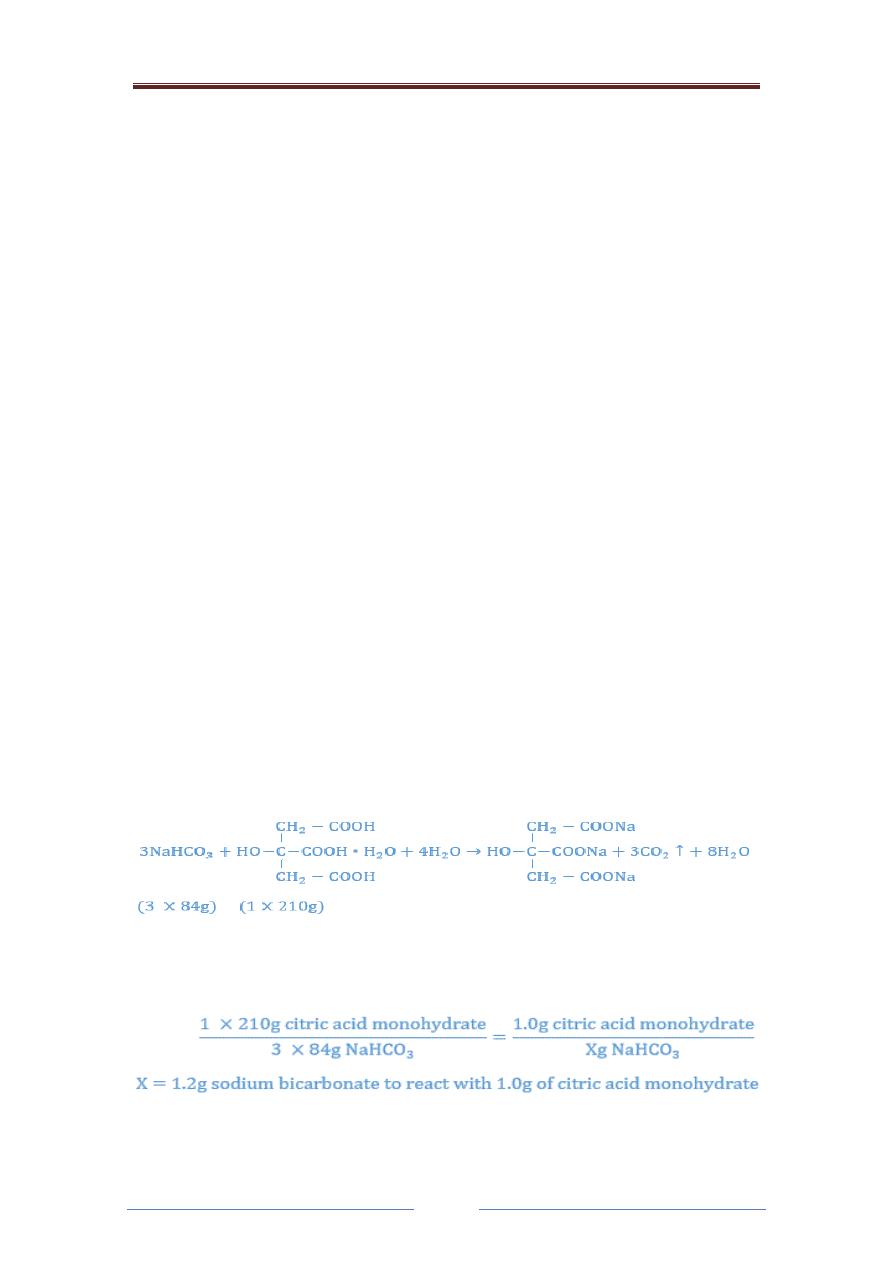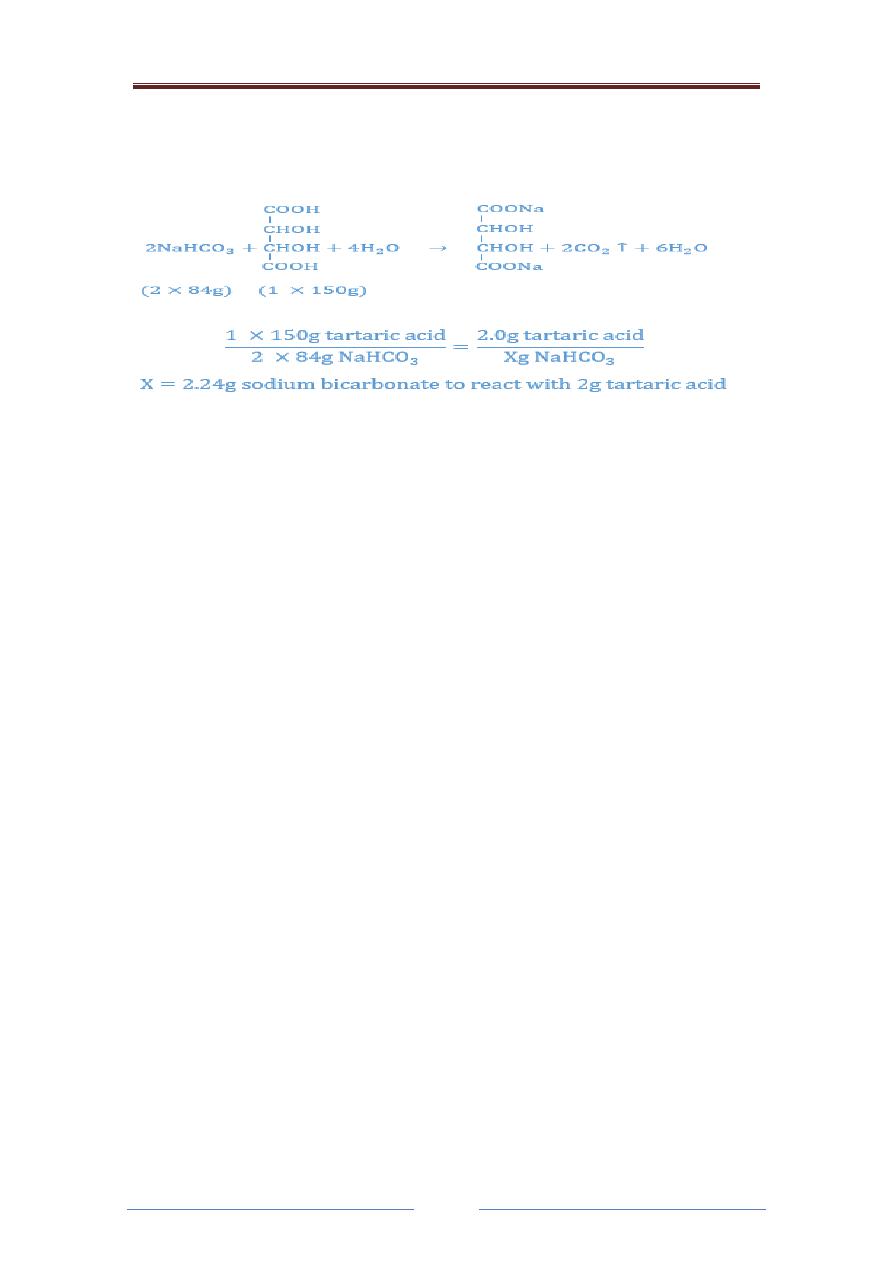
Pharmaceutical industry Lab. Effervescent granules
Page 1
Lab 2
Dr.Hussein
Al Qadisyiah College of pharmacy
Granules
Granules are defined as a dosage form composed of dry aggregates of
powder particles that may contain one or more APIs, with or without
other ingredients. They may be swallowed as such, dispersed in food, or
dissolved in water. Granules are frequently compacted into tablets or
filled into capsules, with or without additional ingredients.
Reason For Granulation
1. To prevent segregation of the constituents of powder Mix
2. To improve the flow properties of the powder mix
3. To improve the compaction characteristics of powder mix
4. Granules have higher porosity than powders
5. To improve the compressibility of powders.
6. The granulation of toxic materials will reduce the hazard of
generation of toxic dust, which may arise during the handling of the
powders.
7. Materials, which are slightly hygroscope, may adhere & form a cake
if stored as a powder.
8. good tasting, sparkling drinks containing ingredients which do not
normally taste good in liquid form
9. high dose products where large conventional tablets would have to
be swallowed
10. quicker and more complete absorption of dosages
11. compounds normally not stable or soluble in liquid form
Effervescent Granulated
An effervescent dosage form, frequently tablets or granules, contains
ingredients that, when in contact with water, rapidly release carbon
dioxide. The dosage form is dissolved or dispersed in water to initiate the
effervescence prior to ingestion.
Effervescent salts are granules or coarse to very coarse powders
containing a medicinal agent in a dry mixture usually composed of
sodium bicarbonate, citric acid, and tartaric acid. When added to
water, the acids and the base react to liberate carbon dioxide, resulting
in effervescence. The resulting carbonated solution masks undesirable
taste of any medicinal agent.

Pharmaceutical industry Lab. Effervescent granules
Page 2
Lab 2
Dr.Hussein
Al Qadisyiah College of pharmacy
Using granules or coarse particles of the mixed powders rather than
small powder particles decreases the rate of solution and prevents
violent and uncontrollable effervescence. Sudden and rapid
effervescence could overflow the glass and leave little residual
carbonation in the solution.
Using a combination of citric and tartaric acids rather than either acid
alone avoids certain difficulties. When tartaric acid is used as the sole
acid, the resulting granules readily lose their firmness and crumble.
Citric acid alone results in a sticky mixture difficult to granulate.
Limitations of effervescent formulations
1. It cannot be given to the children because of possibility of gas (CO2)
toxicity.
2. If packaging is not done properly then there are chances of degradation
by environmental moisture.
3. It has shorter shelf life as compared to other solid dosage forms.
4. It requires special machinery requirements for manufacturing.
5. This dosage form is costly then tablets.
Preparation of Effervescent Granulation
It has been found that citric acid monohydrate and tartaric acid used in
the ratio of 1:2, respectively, produces a powder with good effervescent
properties. The amount of sodium bicarbonate to be used may be
calculated from the reaction which occur when the granules come in
contact with water. The reaction equation between citric monohydrate
and sodium bicarbonate is given below:
Setting up a proportion to determine the amount of sodium bicarbonate
that will react with 1 gm of citric acid, one has:

Pharmaceutical industry Lab. Effervescent granules
Page 3
Lab 2
Dr.Hussein
Al Qadisyiah College of pharmacy
Similar calculations show that 2.24 gm of sodium bicarbonate react with
2
gm
of
tartaric
acid.
Thus, with the acids in a ratio of 1:2, it has been calculated that 3.44 g
(1.2 g + 2.24 g) of sodium bicarbonate is necessary to react
stoichiometrically with the 3 g of combined acids. To enhance the flavor,
the amount of sodium bicarbonate may be reduced to 3.4 gm to allow for
a small amount of unreacted acid to provide a tart taste.
Method of preparation
Dry or Fusion Method
In the fusion method, the one molecule of water present in each molecule
of citric acid acts as the binding agent for the powder mixture. Before
mixing the powders, the citric acid crystals are powdered and then mixed
with the other powders of the same sieve size to ensure uniformity of the
mixture.
The sieves and the mixing equipment should be made of stainless steel
or other material resistant to the effect of the acids.
The mixing of the powders is performed as rapidly as is practical,
preferably in an environment of low humidity to avoid absorption of
moisture and a premature chemical reaction.
After mixing, the powder is placed on a suitable dish in an oven at 34
C to 40 C. During the heating process, an acid resistant spatula is used
to turn the powder. The heat releases the water of crystallization from
the citric acid, which, in turn, dissolves
a portion of the powder
mixture, setting the chemical reaction and consequently releasing
some carbon dioxide.

Pharmaceutical industry Lab. Effervescent granules
Page 4
Lab 2
Dr.Hussein
Al Qadisyiah College of pharmacy
This causes the softened mass of powder to become somewhat
spongy, and when it has reached the proper consistency (as bread
dough), it is removed from the oven and rubbed through a sieve to
produce granules of the desired size. A No. 4 sieve produces large
granules, a No. 8 sieve prepares medium size granules, and a No. 10
sieve prepares small granules.
The granules are dried at a temperature not exceeding 54 C and are
immediately placed in containers and tightly sealed.
Wet Method
The wet method differs from the fusion method in that the source of
binding agent is not the water of crystallization from the citric acid but
the water added to alcohol as
the moistening agent, forming the pliable
mass for granulation. In this method, all of the powders may be
anhydrous as long as water is added to the moistening liquid. Just enough
liquid is added (in portions) to prepare a mass of proper consistency; then
the granules are prepared and dried in the same manner as previously
described.
H.W. Calculate the amount required from CaCO3 and KaHCO3
with citric acid and tartaric acid instead of NaHCO3?
Procedure
1. Weight 2.5 gm of citric acid and 4 gm of tartaric acid and 7 gm of
NaHCO3.
2. Triturate the mixture using pestle and mortar
3. Transfer the content into beaker and heat it on the heater
4. Mix the contents properly
5. Sieve the mixture using NO. 8 sieve
6. Store it in sealed package to prevent premature effervescent
